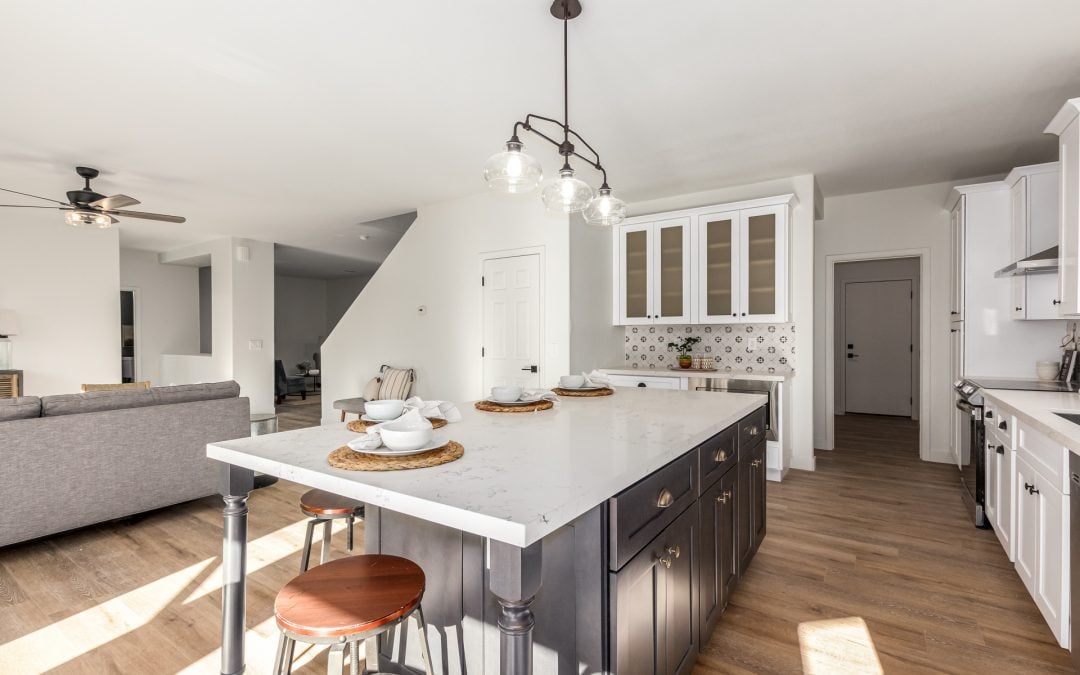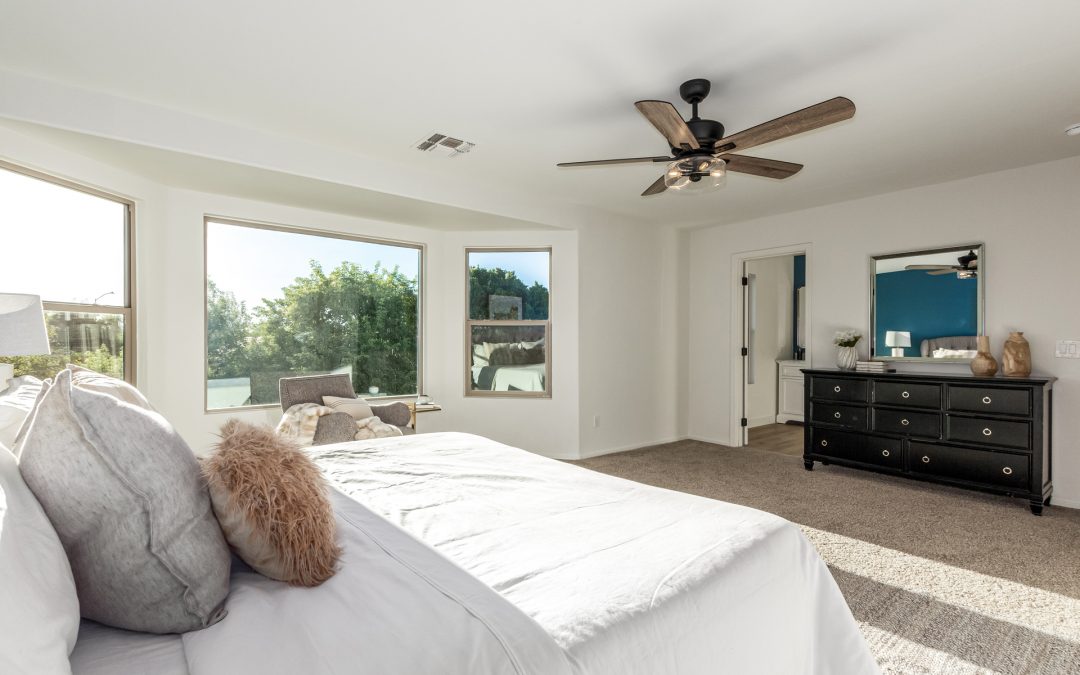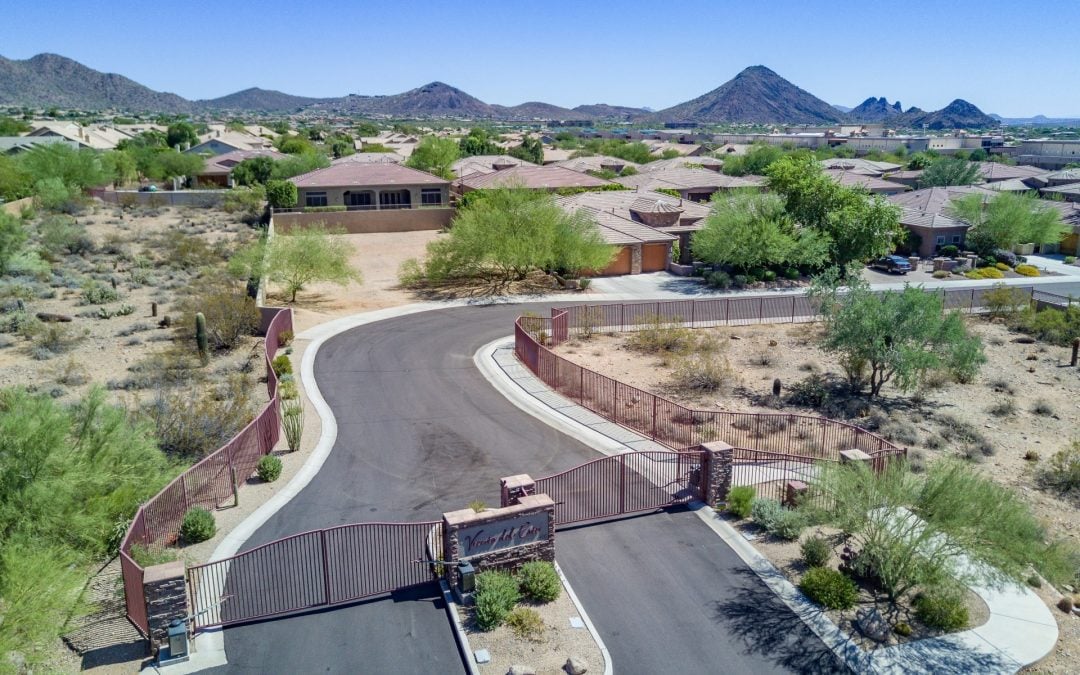
by MICHAEL BODEEN | Jun 27, 2022 | Bodeen Team Blog, Mike's "Real State" of the Market, North Scottsdale News
Mortgage rates may determine how long our (national and Phoenix) current downturn will last. The cost of living, or inflation, may determine interest rates. Lenders don’t make money by loaning to us at less than the rate of inflation. Which is why we always felt that the greatest deal around was a fixed rate mortgage because we were paying the lender back with inflated dollars.
For the average borrower, the current 30-year mortgage rate is now at 6% – assuming you have a mid-700 Credit score or above. For a 50 year context, prior to 2022, the national average mortgage rate from 1971 has been? Jackpot: 7.77%! They have been less than that since 2001. (See Chart below)
“Jim, if rates EVER get below 13% again, we’ll be rich!”
When 30 year mortgage rates were uber cheap, as in before February of this year, and for most of the last 10 years, we Realtors and lenders were living in a most unreal world of cheap rates. Most of my younger colleagues, and certainly those who have been in the business for less than 10 years, would oft roll their eyes when I talk about the good and not-so-good old days, prior to this millennia. And as long as we had a market in balance, all was good.
But alas…
So here we are in 2022, our 6% rates slowing (stopping?) our market. I don’t have any numbers about Realtors leaving the business yet – we’ll know more about that at year’s end when we have to cough up our annual board, MLS, and Realtor dues for 2023. But on the mortgage end, over 75,000 mortgage related jobs nationally have been cut, and lenders are just getting started slicing and dicing. It started last year with the refi market dropping and is now in full swing with purchase apps plummeting.
Will we see 3% Rates Ever Again?
Will we see 3% rates ever again? Only the Lord knows that one, but if we did, it may not be too healthy for us. Honestly, the 5%-6% range may be the real sweet spot. Think about it. How was our market doing at 3%? How was it for first time home buyers as they competed with institutional and private investors who soaked up much of the new inventory of homes coming on the market causing the market to inflate to unsustainable prices?
One of the benefits of our rising market might be the slowing of buyers buying as landlords because the market numbers no longer make economic sense. But, you say, buyers will have to pay a higher monthly payment. Yes, but how would a 6% mortgage look compared to a 7%, 8%, 10% or more rate?
Remember, for long term rates, inflation is the key metric. Look again at the chart, half that chart (25 years) is above the near 8% long term average. I remember saying to a former friend and colleague of mine in Truckee, California in 1984, Jim Orebaugh, “Jim, if rates EVER get below 13% again, we’ll be rich!” No one can tell me or you how high inflation will go!
You say, Mike you’re not an economist, what do you know? You got me there. After all, economists have forecasted nine out of the last five recessions😉

by MICHAEL BODEEN | Jun 20, 2022 | Bodeen Team Blog, Mike's "Real State" of the Market, North Scottsdale News
Not easily forgotten is the winter of 2020, which emerged the reality of a worldwide pandemic not seen in my lifetime. In February 2020, appreciation in the Phoenix and Scottsdale Area real estate market was nearly 10%. There was a six-year period from 2014 to 2020 that had annual appreciation averaging around 5%. That was a normal market.
And then, the pandemic hit. As you can see by the chart below, right after that February, coinciding with the pandemic, immediately the annual (based on monthly) appreciation dropped in March to 8.5%, April to 6.8%, and May to 4.5%. In the midst of this new pandemic, everyone – yes, everyone, expected this to happen – and worsen.
But then, the incredible unforeseen happened. Our market, as well as most metropolitan markets in the U.S., began to soar. Demand took off. Listing inventory, after a brief increase in that 2020 winter, began dropping. Multiple offers and bidding wars became the normal storyline – everywhere. By October of 2020, the annual appreciation rate based on Monthly Price Per Square foot (PSF) hit 19.1%. In February of 2021, that rate was up to 23%. In April it increased to 32%, and it peaked at 38.4% the next month (May 2021).
One year later, as the pandemic is normalizing, folks are now doing what we thought they’d do at the beginning of the pandemic – sell in droves. More listings have been added (11,845) to the Arizona Regional Multiple Listing Service (MLS) in the past 4 weeks than any other 4-week period in the history of the Phoenix MLS, per the Cromford Report.
We are currently getting 34% more new listings than average every 28 days. If this rate continues, it is estimated that a balanced market will return this August. Some of our cities are close to experiencing that balance now.
All this is good news for buyers. What’s not been good news of course is the escalation of mortgage rates – now in the 6% range. Someone reminded me the other day that my real estate career goes back to the 18% mortgage rates in the 80’s. Of course, the huge difference between now and then is the high price of current housing. 18% mortgage rates, which of course halted real estate sales then, happened when the U.S. home median price was under $90,000.
Are we in a meltdown, or will the market pull up? Our counsel to buyers is to take advantage of more homes on the market to find that right one. When inflation gets tamed and comes down to acceptable levels, this market will again change. When will inflation get tamed? That’s the question before us.

by MICHAEL BODEEN | Jun 6, 2022 | Bodeen Team Blog, Mike's "Real State" of the Market
The first buyer benefit to be occurring amidst the current Phoenix Metro market adjustment is the number of homes rapidly coming on the market, hence, increasing inventory.
Another buyer benefit and market gauge we’ll be looking at a little more closely today are the number of downward price changes occurring in the market. But first the main sales numbers for the month of May:
- Active Listings: 9,439 vs 4,917 last year – up 92.0% – and up 41.1% from 6,688 last month
- Under Contract Listings: 10,249 vs 12,317 last year – down 16.7% – and down 5.9% from 10,880 last month
- Monthly Sales: 8,729 vs 9,663 last year – down 9.7% – and down 6.1% from 9,295 last month
- Monthly Average Sales Price per Sq. Ft.: $303.55 vs $248.81 last year – up 22.0% – and up 0.4% from $302.43 last month
- Monthly Median Sales Price: $475,000 vs $390,000 last year – up 21.8% – and up 1.9% from $466,000 last month
Overall, the market is in full reverse.
First, the supply of homes for sale has risen 42% in just the last month and has almost doubled (92%) from one year ago. Next, sales have dropped almost 10% compared with May of 2021. Listings under contract (currently, the best current stat to observe) are down 6% from last month and 17% versus last year.
The highest lagging indicator, closed sales prices, continue to register amazing gains (hmm, those last two words sound like that great ole hymn but I shall refrain from inserting new lyrics😉). The monthly average sales price per square foot has increased 22% from one year ago and 0.4% from last month – quite substantial still! The monthly median sales price is creeping towards a half million and is currently at $475,000 – a 21.9% gain from last year’s median of $390,000 and almost 2% higher than last month, which was $466,000.
Sellers are now strongly responding to our moving market. Price cuts are now happening at an increasing rate. Last week alone, 1764 properties changed price with a median reduction of $11,000. This is a significant sign of seller determination to get ahead of our changing market. The last week that we’ve had as many price changes was November of 2019.
The great unknown is whether this is a short-lived cycle. The recent substantial rise of mortgage rates in a two-month period is without question bolstering inventory. The buyer window for increasing their home choices may (will?) only last as long as rates remain higher. If inflation begins to cool (note “if”) rates will drop and the fever to jump back into buying will strongly increase, bringing back many multiple offers, and the rise of prices.
So, I believe we’re in a window of opportunity for buyers. If they can swing it and can find that “right” home. Gopherit!

by MICHAEL BODEEN | May 30, 2022 | Bodeen Team Blog, Mike's "Real State" of the Market, North Scottsdale News
I am a blessed man, and how well I know it! I found (fell into) a career in my very early 20’s that I have enjoyed immensely. For sure, it’s had its ups and downs. In fact when Karen and I were married, I had stepped out of real estate for a 9 month period and was never going to go back into commission sales again – EVER! Why? Because I couldn’t make a sale to save my soul. It was a period of sky-high mortgage rates, around 14%, which had come down from a record 18.45% in 1981.
The only way I got back into real estate was because a kind man named Glen Chileski hired me to manage ERA Truckee Tahoe Realty and put me on a salary, with commissions, and overrides. I owe that man a debt of huge magnitude. I got to work in a business that was different every day of the year, presenting numerous challenges, interacting with vastly different people, and it provided for my family.
But oh, the ebb and flow!
A wise King once said, “That which has been is that which will be, and that which has been done is that which will be done. So, there is nothing new under the sun.”
King Solomon could have been talking about modern day stock or real estate markets – particularly now as it relates to the changing housing market and the
numerous career changes that are and will be unfolding in the months ahead.
“Realtor contraction will happen also. It always does when change happens in the industry. I witnessed many leave the business when MLS computerization entered the real estate marketplace in the 80’s taking the place of our beloved real estate books.”
Beginning in 2007, millions of folks lost their job in the Great Recession when we experienced the bursting of the housing bubble. In the years that followed, tens of thousands of foreclosures were happening each year. We Realtors were surviving on doing “short sales.” In all my history of working in this industry, that was the bleakest. Right and left, friends and neighbors were losing their homes. Thousands of Realtors threw in the career towel during that distressing market.
And what of the present? We’re beginning to see large scale layoffs in the mortgage industry as thousands of jobs are being eliminated as new purchase mortgages and refinances fall off the table due to the rising mortgage rates that now exceed 5%. (That last sentence -5%- blows my mind)
Realtor contraction will happen also. It always does when change happens in the industry. I witnessed many leave the business when MLS computerization entered the real estate marketplace in the 80’s taking the place of our beloved real estate books. Now, with low inventory, huge corporate investors buying up homes for rentals, sales are dropping. The reduction of first time and move-up buyers due to higher rates doesn’t help either
The next wave of change is now happening. There is nothing new under the sun! Not even our hot Scottsdale sun!

by MICHAEL BODEEN | May 23, 2022 | Bodeen Team Blog, Buying a Home, Featured Communities, Mike's "Real State" of the Market, Real Estate News
It’s in our nature. We want to buy low and sell high. “Timing the Market” is certainly on the lips of lots of stock market pundits these days – and is now a part of the residential real estate discussion, both locally here in Scottsdale and Phoenix, and nationally.
Questions abound: Has our market peaked? If not, when will it? If I’m buying, should I buy now or wait for more supply and lower prices? Will mortgage rates continue rising or will they decrease, or at least stabilize? Open the envelope, please. (Just kidding😉)
What we do know, is that sales prices are continuing to rise (market lag) and will do so for a number of (unknown) months until homes take longer to sell (now happening), and asking prices begin to drop (now happening).
The good news for buyers, is that supply is increasing – rabidly and rapidly. Active supply has increased 71% over the same time last year (as of May 21st). And per the Cromford report, it has increased 45% in just the past 30 days, though still historically low
What is most interesting is that, again, per Cromford, it’s “not coming from a massive flood of new listings hitting the market. New listings are at normal levels, and not excessive, but fast rising mortgage rates and fewer sales have reduced the number of accepted contracts.” If sellers want to hit the peak of the market, now may be the time to sell, but as has been questioned by Mike’s Market Snapshot ad nauseum in the past months, “THEN what are you gonna do?”
“If you can afford it, be on the lookout to find the right home that you will enjoy living in day after day. And if you find it, go for it. After all, isn’t a home’s enjoyment the right investment strategy?”
With massive untold millions of homeowners having sub-3% mortgage rates, why would they want to sell and step up to 5.5% current rates, unless their existing situation mandates they sell, such as relocation out of the Valley, or regular ole life issues of births and deaths. This could include us aging boomers going into assisted living, and/or investors wanting to sell at the top of the market. The latter would not appear to be much in play however, as right now, investors are reaping the whirlwind of the highest rental returns ever.
And to buyers, my advice remains: If you can afford it, be on the lookout to find the right home that you will enjoy living in day after day. And if you find it, go for it. After all, isn’t a home’s enjoyment the right investment strategy?

by MICHAEL BODEEN | May 9, 2022 | Bodeen Team Blog, Mike's "Real State" of the Market
It’s happening folks, right before our eyes. The market is changing, umm, cooling. But before we go there, we’ll report on April’s sales numbers:
- Active Listings: 6,688 versus 5,080 last year – up 31.7% – and up 32.4% from 5,051 last month
- Under Contract Listings: 10,889 versus 12,187 last year – down 10.7% – and down 6.3% from 11,620 last month
- Monthly Sales: 9,270 versus 10,200 last year – down 9.1% – and down 8.6% from 10,144 last month
- Monthly Average Sales Price per Sq. Ft.: $302.64 versus $243.36 last year – up 24.4% – and up 4.1% from $290.75 last month
- Monthly Median Sales Price: $466,000 vs $373,000 last year – up 24.9% – and up 2.3% from $456,000 last month
As you can see, the numbers continue to change favoring buyers. Listings are up over 32% in just the last month. Under contract listings are down compared to last year AND last month. Sales are down 9% from last year, and almost 9% since last month. And in one of the few owner bright spots, sales prices, the lagging indicators, are up 24% versus last year, and, get this, over 4% from just last month.
For a few more months perhaps, we will continue to read of increasing sales prices, as sales are closing higher due to existing pending sales in the past weeks. But soon enough, if the current trend continues (and it will), inventory will continue to increase providing buyers with many more choices and less competition. Alas, we could well be on our way to a more normal market – a novel Phoenician thought, for sure.
But soon enough, if the current trend continues (and it will), inventory will continue to increase providing buyers with many more choices and less competition.
But then there are the investors. What’s up their sleeves?
Real estate investors can be pretty savvy. The successful ones understand market dynamics. They know “when to hold em, and when to fold em.” Today’s large scale investors, like the huge behemoths in the stock market, can often determine (manipulate?) direction for an entire market.
Since mortgage rates have escalated to over 5.5% recently, the regular mom and pop market, including first time homebuyers and move-up homebuyers, is slowing.
So, how are investors reacting to the market? Or asked another way, what should a shrewd investor be looking to do?
The current Phoenician investor, in my opinion, unlike stock market sellers, will be pulling back on purchases, but not liquidation. If buyers aren’t buying, they’re renting. The rental market will not be slowing until (if and when) new home construction, apartments, etc catches up to the demand. This could then further slow the sales market. Investors will wait and only look for the best buys that are out there – and they could have plenty to choose from.







